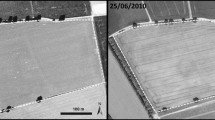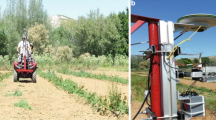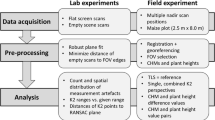Abstract
Knowledge of site-specific crop parameters such as plant height, coverage and biomass density is important for optimising crop management and harvesting processes. Sensors for measuring crop parameters are essential pre-requisites to gather this information. In recent years, laser rangefinder sensors have been adopted in many industrial applications. In agricultural engineering, the potential of laser rangefinders for measuring crop parameters has been little exploited. This paper reports the design and the performance of a measuring system based on a triangulation and a time-of-flight laser rangefinder for estimating crop biomass density in representative crops under field conditions. It was shown that the mean height of reflection point is a suitable parameter for non-contact indirect measurement of crop biomass by laser rangefinder sensors. The main parameters for potential assessment were the coefficient of determination (R 2) and the standard error (RMSE) for the relation between crop biomass density and the mean height of the reflection point in crop stands from oilseed rape, winter rye, winter wheat and grassland during the vegetation period in 2006. For the triangulation sensor, R 2 was in the range from 0.87 to 0.98 and for the time-of-flight sensor in the range from 0.75 to 0.99 for both fresh matter and dry matter density. The triangulation sensor had a reduced suitability caused by masking effects of the reflected beam and because of limited measuring range. Based on the results of experiments and technical data, it was concluded that the time-of-flight principle has good potential for site-specific crop management.








Similar content being viewed by others
References
Bienert, A., Scheller, S., Keane, E., Mullooly, G., & Mohan, F. (2006). Application of terrestrial laserscanners for the determination of forest inventory parameters. In International archives of photogrammetry, remote sensing, and spatial information sciences, Vol. XXXVI, Part. 5. http://www.isprs.org/commission5/proceedings06/paper/1270_Dresden06.pdf/. Accessed 3 March 2009.
Ehlert, D., & Adamek, R. (2007). Messeigenschaften von Laser-Abstandssensoren [Measuring properties of laser rangefinders]. Agricultural Engineering Research, 13(4), 119–128.
Ehlert, D., Adamek, R., & Horn, H.-J. (2007). Assessment of laser rangefinder principles for measuring crop biomass. In J. V. Stafford (Ed.). Precision Agriculture’07: Proceedings of the 6th European conference on precision agriculture (pp. 317–324). NL: Wageningen Academic Publishers.
Ehlert, D., & Dammer, K.-H. (2006). Widescale testing of the crop-meter for site-specific farming. Precision Agriculture, 7, 101–115. doi:10.1007/s11119-006-9003-z.
Ehlert, D., Kraatz, S., & Adamek, R. (2006). Höhenführung für Laser-Abstandssensoren [Height control for laser rangefinders]. Agricultural Engineering Research, 12(5), 85–92.
Ehsani, R., & Lang, L. (2002). A sensor for rapid estimation of plant biomass. In P. Robert (Ed.), Proceedings of the 6th international conference on precision agriculture. ASA/CSSA/SSSA, Madison, WI, USA. CDROM.
Heege, H. J., Reusch, S., & Thiessen, E. (2004). Systems for site specific on the go control of nitrogen top-dressing during spreading. In D. J. Mulla (Ed.), Proceedings of the 7th international conference on precision agriculture. Minneapolis, USA: ©Regents University of Minnesota.
Holmes, G., Bodley, J., Meadows, P. J., & Poilve, H. (2004). Integrating synthetic aperture radar with optical information for crop management applications. In D. J. Mulla (Ed.), Proceedings of the 7th international conference on precision agriculture. Minneapolis, USA: ©Regents University of Minnesota. CDROM.
Hutchings, N. J., Phillips, A. H., & Dobson, R. C. (1990). An ultrasonic rangefinder for measuring the undisturbed surface height of continuously grazed grass swards. Grass & Forage Science, 45, 201–209. doi:10.1111/j.1365-2494.1990.tb02192.x.
Lenaerts, B., Craessaerts, G., De Baerdemaeker, J., & Saeys, W. (2008). Crop stand density prediction using LIDAR-sensors. In International conference on agricultural engineering, Hersonissos-Crete, Greece, OP 390.
Meyer, U. (1997). Growth stages of mono and dicotyledonous plants. Blackwell Wissenschafts-Verlag Berlin Wien, ISBN 3-8263-3152-4.
Paul, W., & Speckmann, H. (2002). Measuring crop density and soil humidity by pulsed radar. EurAgEng, Paper no. 02-AE-001, AgEng 02 International Conference, Budapest, Hungary.
Scotford, I. M., & Miller, P. C. H. (2003). Characterisation of winter wheat using measurements of normalised difference vegetation index and crop height. In J. Stafford & A. Werner (Eds.), Precision agriculture: Proceedings of the 4th European conference on precision agriculture (pp. 621–626). NL: Wageningen Academic Publishers.
Sigrimis, N., Hashimoto, Y., Munack, A., & De Baerdemaeker, J. (1999). Prospects in agricultural engineering in the information age—technological developments for the producer and consumer. Agricultural Engineering International: The CIGR Journal of Scientific Research and Development, 1. http://cigr-ejournal.tamu.edu/submissions/volume1/Invited_InfoTech/InfoTech.pdf/. Accessed 3 March 2009.
Thösink, G., Preckwinkel, J., Linz, A., Ruckelshausen, A., & Marquering, J. (2004). Optoelektronisches Sensorsystem zur Messung der Pflanzenbestandesdichte. Landtechnik, 2, 78–79. Optoelectronic sensor system for crop density measurement.
Tumbo, S. D., Salyani, M., Whitney, J. D., Wheaton, T. A., & Miller, W. M. (2002). Investigation of laser and ultrasonic ranging sensors for measurements of citrus canopy volume. Applied Engineering in Agriculture, 18(3), 367–372.
Walklate, P. J., Cross, J. V., Richardson, G. M., Murray, R. A., & Baker, D. E. (2002). Comparison of different spray volume deposition models using LIDAR measurements of apple orchards. Biosystems Engineering, 82(3), 253–267. doi:10.1006/bioe.2002.0082.
Wehr, A., & Lohr, U. (1999). Airborne laser scanning—an introduction and overview. ISPRS Journal of Photogrammetry and Remote Sensing, 54, 68–82. doi:10.1016/S0924-2716(99)00011-8.
Acknowledgments
We like to thank our co-workers A. Anlauff and U. Frank for their support in preparing and executing the tests.
Author information
Authors and Affiliations
Corresponding author
Rights and permissions
About this article
Cite this article
Ehlert, D., Adamek, R. & Horn, HJ. Laser rangefinder-based measuring of crop biomass under field conditions. Precision Agric 10, 395–408 (2009). https://doi.org/10.1007/s11119-009-9114-4
Received:
Accepted:
Published:
Issue Date:
DOI: https://doi.org/10.1007/s11119-009-9114-4




